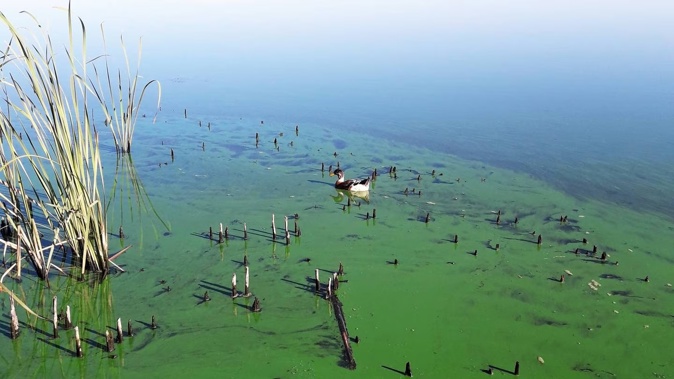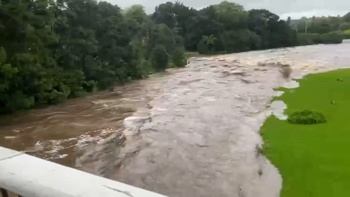
Key points:
- 45 per cent of lake monitoring sites worsened between 2011 and 2020, with just 36 per cent improving.
- 45 per cent of New Zealand’s total river length is unswimmable, according due to risk of bacterial infection.
- 48 per cent of the country’s river network is at least partially inaccessible to migratory fish.
- About two-thirds of freshwater native bird species were either threatened with extinction or at risk of becoming threatened in 2021.
- More than 4200 reported wastewater overflows in the 12 months from July 2020 to June 2021.
Scientists are accusing Labour of broken promises on improving the dismal state of the country’s lakes and rivers with the latest stocktake painting an “appalling” picture with most measures worsening despite nearly six years in Government.
Our freshwater 2023, produced by the Ministry for the Environment and Statistics NZ, shows while there have been some minor improvements, on most measures the country’s freshwater sources are becoming increasingly polluted, further threatening native species on the verge of extinction and causing more people to become sick.
The report, part of a monitoring series produced every three years, found 45 per cent of lake monitoring sites between 2011 and 2020 had become more polluted with nutrients and algae, and 45 per cent of the country’s entire river length was deemed unswimmable due to risk of bacterial infection over the period 2016 to 2020.
The report noted the increasing pressures from changing land use, including still increasing levels of fertiliser being used, intensification of farming - more livestock in smaller spaces - alongside thousands of urban wastewater discharges.
Freshwater scientist and Victoria University senior researcher Dr Mike Joy said Labour had campaigned on turning around the country’s water woes yet had failed to tackle the heart of the problem.
“A lot of people say [freshwater water issues] is what won them the 2017 election, or at least helped National lose.
“Well nothing has improved, because nobody wants to tackle the source of the problem.”
Joy said Labour’s attempts to fix the country’s water woes equated to putting towels around a pot to stop it boiling over.
“Nobody is turning the gas down, and the gas is intensive farming.
“The number one impact on water quality is way too much fertiliser, way too much cattle.”
Joy likened it to the difficulties in getting action on climate change with the economy so tied in with fossil fuels.
“As long we ignore the source nothing is going to change.”
The report itself does shy away from that fact, noting Aotearoa has experienced one of the highest rates of agricultural land intensification over recent decades internationally.
/cloudfront-ap-southeast-2.images.arcpublishing.com/nzme/JEPAXS63ZJFB5KGWSAC25ZPSEA.jpg)
Freshwater scientist Dr Mike Joy. Photo / Alexander Robertson
Between 1996 and 2018, almost 60,000 hectares of exotic grassland was converted from low-producing to high-producing land - an area 2.5 times the size of Abel Tasman National Park.
Urban land swallowing up previously highly-productive land had also contributed to an increase in intensive farming on remaning land.
Dairy cattle numbers increased by 82 per cent nationally from 3.4 million to 6.3 million between 1990 and 2019.
Irrigated land doubled between 2002 and 2019, with around 73 per cent of this increase attributable to dairy intensification.
Dr Tim Chambers of Otago University’s Department of Public Health said the report outlined the “core pressures” that led to the degradation of freshwater, and with it the serious economic, socio-cultural and health implications.
The national ground water monitoring programme shows that 68 per cent and 19 per cent would fail the drinking water standards for bacterial and nitrate contamination, respectively.
For bacterial contamination, 82 per cent of all sites were either getting worse (50 per cent) or showing no improvement (32 per cent). For nitrate, 51 per cent were either getting worse (35 per cent) or not improving (16 per cent).
An estimated 45 per cent of our river length was not suitable for swimming due to bacterial contamination. In 2017, 1200 people got sick after reporting contact with recreational water.
“The report does clearly show that further action is required to protect our freshwater for our physical and economic wellbeing,” said Chambers.
Joy said while the report did not shy away and “unflinchingly identifies the appalling state of lowland freshwaters of Aotearoa”, he was disappointed with the statistical reporting quality.
The latest data it uses is from 2020, despite 2023 data existing. He also said it failed to take a more holistic approach, which the authors themselves identified as a data and research gap.
The Government has signalled the new legislation replacing the Resource Management Act (RMA) will help address freshwater pollution issues, which Environment Minister David Parker has likened to “death by a thousand cuts” due to its piecemeal approach.
The new Natural and Built Environments Act would set environmental bottom lines, along with moving from an effects-based approach to one based on outcomes.
Joy said he didn’t think this would have much of a difference as it still ignored the root cause of the pollution.
“It’s the same with Three Waters reforms, none of it tackles the real problem. Dairy is like a religion in this country.”
Ministry for the Environment spokeswoman Natasha Lewis said while freshwater ecosystems and water quality were improving in some places and for some measures, others were worsening.
“Many lakes, rivers and other water bodies are under pressure, mostly due to the way we’re using land and water, and from the changing climate,” she said.
Statistics NZ spokesman Jason Attewell said the report provided evidence-based data to enable informed decision-making and prompt discussion about the present and future.
Take your Radio, Podcasts and Music with you









